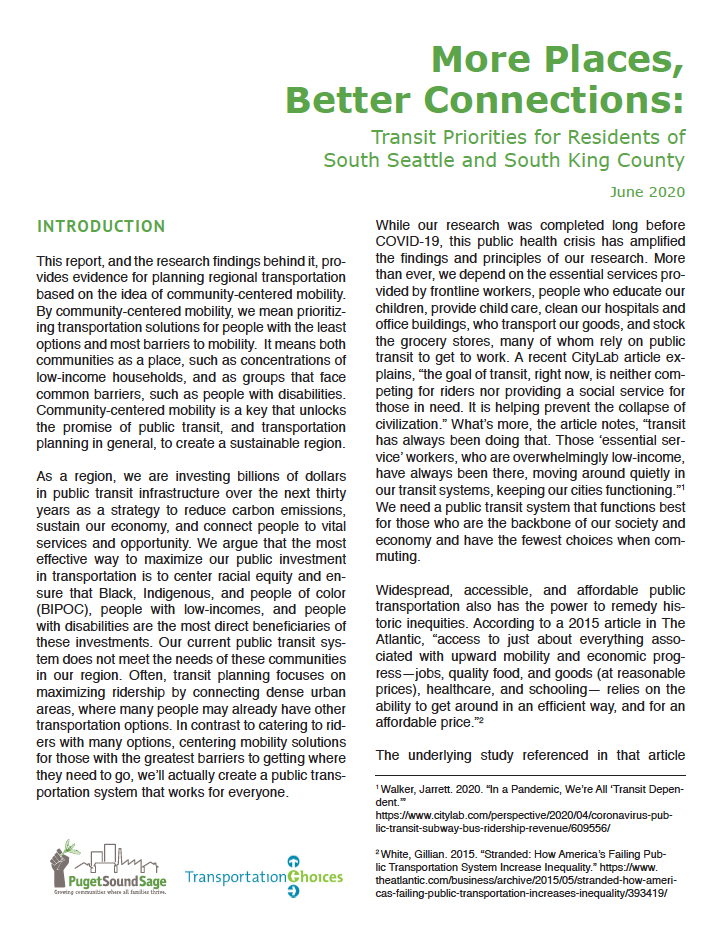More Places, Better Connections
Transit Priorities for Residents of South Seattle and South King County
Across our region, we are investing billions of dollars in public transit infrastructure over the next thirty years. At Puget Sound Sage, we have long supported building a public transportation system that connects low-wage workers, BIPOC communities, and people with disabilities to work, to healthcare, to childcare, to school, and to community, cultural, and faith centers. We believe public transit can create good jobs, reduce carbon emissions, and increase public health and well-being.
Through recent research conducted by Puget Sound Sage and Transportation Choices Coalition, we argue that the most effective way to maximize our public investment in transportation is to center racial equity and ensure that Black, Indigenous, and people of color (BIPOC), people with low-incomes, and people with disabilities are the most direct beneficiaries of these investments. Our current public transit system does not meet the needs of these communities in our region. Often, transit planning focuses on maximizing ridership by connecting dense urban areas, where many people may already have other transportation options. In contrast to catering to riders with many options, centering mobility solutions for those with the greatest barriers to getting where they need to go, we’ll actually create a public transportation system that works for everyone.
Throughout the fall of 2018 and early 2019 we partnered with four community-based organizations in Seattle and South King County to better understand mobility and transportation priorities through a survey of their members.[1] Their members are predominately Black, Indigenous, people of color, low-income, immigrants and refugees, which are typically not the focus of transportation surveys. Over the course of four months our partners collected 532 surveys.
Here are our findings:
Mismatch of commute patterns to current transit network: Our current regional transit system was developed for the commuter that comes to work in downtown Seattle each day. However, our respondents were more likely to commute to destinations outside of downtown Seattle and aren’t served well by a hub and spoke system. Overall, 73% of respondents commute to a destination outside downtown Seattle. Two in five (40%) of all respondents live outside of Seattle, the vast majority (80%) of whom report commuting to a destination outside of downtown Seattle. Our current transit network does not serve these riders.
Access to transit is poor measure for actual use: Proximity to transit does not necessarily mean people will take it or that it provides a good transportation option. While more than most (64%) of respondents report living near a transit stop, only 29% and 38% of respondents feel that transit got them places on time and on a day-to-day basis, respectively.
Transit is not affordable to most: 60% of respondents reported that transit was very or somewhat unaffordable. Nearly 30% reported using ORCA LIFT program and only 17 % had access to employer-provided transit subsidies or use of monthly passes.
What Would Help Me Ride Transit More? Across all groups we identified as being most impacted by current mismatches with the transit system, respondents indicated three major priorities that would increase their use: reducing overall commute times (61%), investing in improvements that reduce the number of transfers or create a more direct route to most frequented destination (53%), and ensuring that the places people need to go to, like work, childcare, healthcare, and groceries, are co-located near transit (45%). The top priorities for improving our public transit system are in some way connected to the length of time spent commuting, which relates back to the limited choices BIPOC households with low-incomes, and people with disabilities face in our transportation system.
What Comes Next?
As agencies scramble to account for anticipated revenue shortfalls due to COVID-19, we must protect hard-won programs and services in support of the above goals. We must also support agencies in using racial and social equity as a guiding principle for cuts – maintaining or protecting transit that serves the essential workers and trips by highly impacted populations.
In an effort to keep the busses running in Seattle, Seattle City Council members recently agreed to put a renewal of the Seattle Transportation Benefit District on the ballot in November. While mitigating cuts to service and maintaining transit affordability in Seattle is critical, voters will be forced to choose between a regressive sales tax increase or significant cuts. This is not a choice we should have to make.
Our research confirms that we must radically expand regional transit connections – to schools, to healthcare, to grocery stores, to childcare, to senior centers and this type of equitable investment in transit will simultaneously require new progressive revenue options at the state.
If we as a region want to build out a transportation system for all people and communities, we need to prioritize the mobility of those whose transportation needs are not being met. By focusing on outcomes by and for BIPOC, low-income, and people with disabilities – those with the fewest choices and who are most burdened by poor transportation options – we can deliver a just transportation system.
[1] Tenant’s Union of WA, Rainier Beach Action Coalition, InterIm Community Development Association, and Casa Latina.

